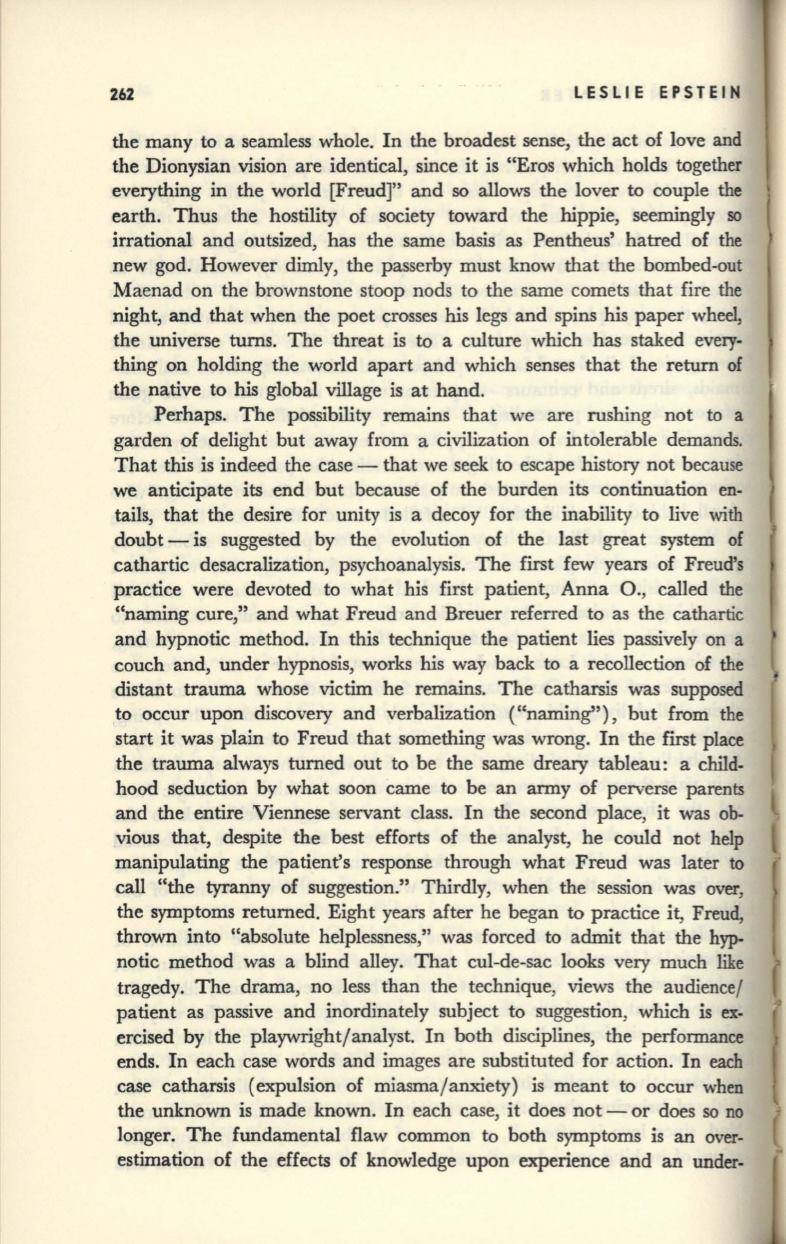
262
LESLIE EPSTEIN
the many to a seamless whole. In the broadest sense, the act of love and
the Dionysian vision are identical, since it is "Eros which holds together
everything in the world [Freud]" and so allows the lover to couple the
earth. Thus the hostility of society toward the hippie, seemingly
so
irrational and outsized, has the same basis as Pentheus' hatred of the
new god. However dimly, the passerby must know that the bombed-out
Maenad on the brownstone stoop nods to the same comets that fire the
night, and that when the poet crosses his legs and spins his paper wheel,
the universe turns. The threat is to a culture which has staked every–
thing on holding the world apart and which senses that the return of
the native to his global village is at hand.
Perhaps. The possibility remains that we are rushing not to a
garden of delight but away from a civilization of intolerable demands.
That this is indeed the case - that we seek to escape history not because
we anticipate its end but because of the burden its continuation en–
tails, that the desire for unity is a decoy for the inability to live with
doubt - is suggested by the evolution of the last great system of
cathartic desacralization, psychoanalysis. The first few years of Freud's
practice were devoted to what his first patient, Anna 0., called the
"naming cure," and what Freud and Breuer referred to as the cathartic
and hypnotic method. In this technique the patient lies passively on a
couch and, under hypnosis, works his way back to a recollection of the
distant trauma whose victim he remains. The catharsis was supposed
to occur upon discovery and verbalization ("naming"), but from the
start it was plain to Freud that something was wrong. In the first place
the trauma always turned out to be the same dreary tableau: a child–
hood seduction by what soon came to be an army of perverse parents
and the entire Viennese servant class. In the second place, it was ob–
vious that, despite the best efforts of the analyst, he could not help
manipulating the patient's response through what Freud was later to
call "the tyranny of suggestion." Thirdly, when the session was over,
the symptoms returned. Eight years after he began to practice it, Freud,
thrown into "absolute helplessness," was forced to admit that the hyp–
notic method was a blind alley. That cul-de-sac looks very much like
tragedy. The drama, no less than the technique, views the audience!
patient as passive and inordinately subject to suggestion, which is ex–
ercised by the playwright/analyst. In both disciplines, the performance
ends. In each case words and images are substituted for action. In each
case catharsis (expulsion of miasma/anxiety) is meant to occur when
the unknown is made known. In each case, it does not - or does so no
longer. The fundamental flaw common to both symptoms is an over–
estimation of the effects of knowledge upon experience and an under-


